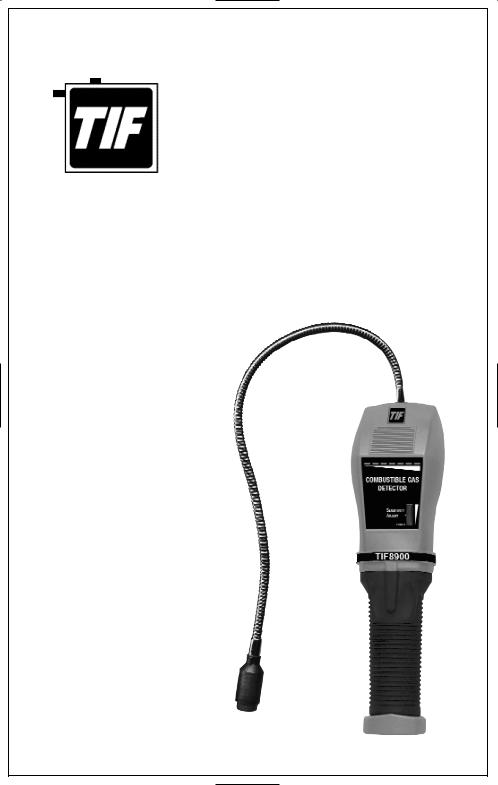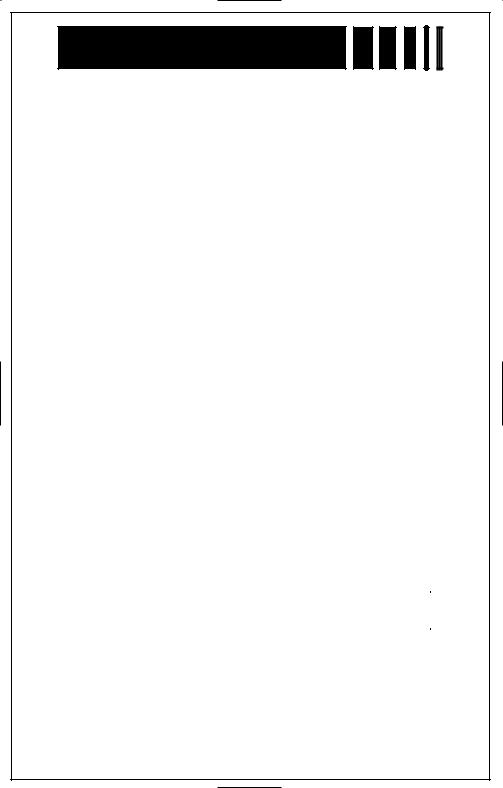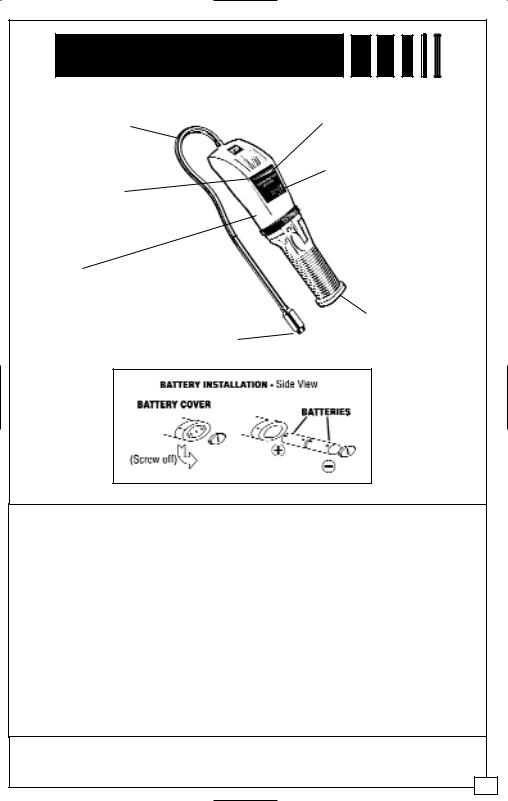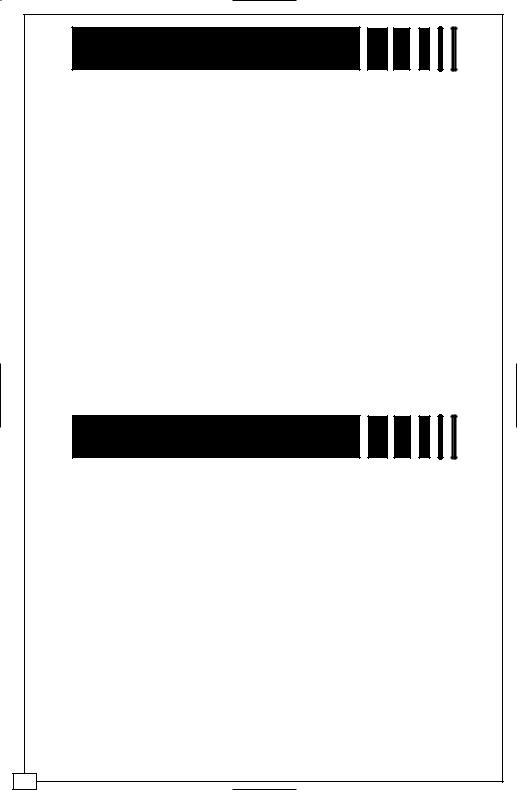TIF 8900 User Manual [en, de, es, fr]

Combustible
Gas Detector
OWNER’S MANUAL
MANUAL DEL PROPRIETARIO MANUEL DE L’UTILISATEUR BEDIENUNGSANLEITUNG
TIF8900

TABLE OF CONTENTS
General Information
 2
2
Parts & Controls
 3
3
Features
 4
4
Set-up
 4
4
Warnings & Cautions
 4
4
Operating Instructions
 5
5
Applications
 5
5
Maintenance
 6
6
Specifications
 6
6
Replacement Parts
 6
6
Warranty
 7
7
Español
 7
7
Français  12
12
Deutsch 16
16

GENERAL INFORMATION
The TIF8900 tool is broad-band, battery operated, solid state electronic combustible gas detector.
The instrument provides a “geiger counter” ticking signal which increases in frequency as the source of combustible gas or vapor is approached. It is excellent for pinpointing the location of combustible gas leaks as low as 5 PPM. This unit includes a carrying case, owner’s manual, rechargeable batteries and recharger.
The unit is ideal for pinpointing known leaks, checking for leaks and verifying safety of potentially hazardous locations.
ATTENTION:
Batteries must be charged for 24 hours before initial use. If this is not done, the unit will not function properly.
WARNING:
Damage to batteries and unit WILL occur if batteries are installed backwards.
|
|
S |
|
S IFI |
|
|
{ |
|
|
A |
E |
C |
L |
D |
|
|
|
71M3
CLASSIFIED BY UNDERWRITERS LABORATORIES INC® ONLY AS TO INTRINSIC SAFETY IN CLASS I GROUPS A,B,C, & D HAZARDOUS LOCATIONS.
2

PARTS AND CONTROLS
Flex Probe (1) |
Visual Leak Size |
|
Indicators (3) |
|
Off-On (4) |
Constant Power |
Sensitivity Adjust (5) |
indicator (6) |
|
Battery
Charger
Jack (7)
NI-Cad
Batteries (8)
Sensing Tip (2)
Español
(1)Sonda flexible
(2)Punta sensora
(3)Indicadores visuales del tamaño de la fuga
(4)Off-On (Interruptor deslizante)
(5)Adjuste de la sensibilidad
(6)Luz indicatdora constante de la baterÍa
(7)Enchufe del cargador de la batería. Conecte el cargador al tomacorriente e inserte el enchufe en la toma del instrumento.
(8)TIF8806 Baterías Ni-Cad.
Quite la tapa de la batería. Instale las baterías en la forma que se indica en el compartimiento para las baterías.
|
Français |
|
Deutsch |
(1) |
Sonde flexible |
(1) |
Flexsonde |
(2) |
Pointe de détection |
(2) |
Sondenspitze |
(3) |
Témoins lumineux de niveau de |
(3) |
Visuelle Leckstärkenanzeige |
|
fuite |
(4) |
Ein-Aus (Schiebeschalter) |
(4) |
Marche-arrêt (Interrupteur |
(5) |
Empfindlichkeitsregler |
|
d’alimentation à glissière) |
(6) |
Konstante Batteriestatusanzeige |
(5) |
Réglage de la sensibilité. |
(7) |
Anschlußbuchse für Batterie- |
(6) |
Témoin de charge de pile |
|
Ladegerät Das Batterie-Ladegerät |
(8) |
Prise du chargeur de piles. |
|
an einer Steckdose und am Gerät |
|
Branchez le chargeur de piles à la |
|
anschließen. |
|
prise d’alimentation et insérez la |
(8) |
TIF8806 Ni-Cad-Batterien. |
|
fiche dans la prise de l’appareil. |
|
Abdeckung vom Batteriefach |
(8) |
TIF8806 Piles au Ni-cad |
|
ebnehmen. Batterien wie |
|
Retirez le couvercle du logement |
|
dargestellt im Batteriefach einset- |
|
des piles. Installez les piles en |
|
zen. |
|
suivant les indications figurant |
|
|
|
dans le logement. |
|
|
3

FEATURES
• Solid state sensor technology, long life and |
• Automatic warm up |
||||||||||||
precision |
• Cordless operation |
||||||||||||
• Broad band of combustible gas detection |
• Flexible 16" stainless probe for hard to |
||||||||||||
• Sensitivity as low as 5 ppm |
reach places |
||||||||||||
• Adjustable sensitivity |
• Rechargeable battery and charger included |
||||||||||||
• Audible "Geiger counter" signal |
• Rugged custom carrying case |
||||||||||||
• LED Leak Intensity Lights |
• Made in the USA |
||||||||||||
|
|
|
|
|
|
|
|
|
|
|
|
|
|
|
SET-UP |
|
|
|
|
|
|
|
|
|
|
|
|
|
|
|
|
|
|
|
|
|
|
|
|
|
|
|
|
|
|
|
|
|
|
|
|
|
|
|
|
Before using your new instrument, it is necessary to install and charge the supplied Ni-Cad batteries. NOTE the Warnings and Cautions below.
1.Install batteries as indicated in the diagram on page 3; pay careful attention to the polarity indication.
2.Place the unit in a non-hazardous location and plug the charger into an electrical outlet.
3.Insert the plug into the jack on the back of the instrument.
Note: Initially it is necessary to charge the batteries for 24 hours. Subsequent recharges can normally be done in approximately 12-16 hours.
WARNINGS & CAUTIONS
Caution:
•The unit should always be switched on and calibrated in non-contaminated atmosphere in order to insure correct operation and indication.
•Approach suspected hazardous areas with the unit on.
•Always check the instrument on a known combustible leak source before using.
WARNING!
•Batteries must only be changed or recharged in an area known to be non-hazardous. To avoid damage to the recharger or unit, make sure the recharger plug is completely plugged into the unit and the batteries are installed in the correct orientation.
•Do not operate the unit with charger plugged into the wall outlet.
•After the automatic warm-up period, move the sensitivity adjustment through its complete range. A change in the ticking rate should be heard ascending from a ticking
sound to a siren. If this does not occur, do not use the instrument! Recharge the batteries and/or replace sensing element. Repeat the above described test procedure. If this does not correct the problem, the instrument should be returned for repair.
4

OPERATING INSTRUCTIONS
Once the batteries are fully charged, the instrument is ready to use (before use, carefully read and understand the Warnings and Cautions on the previous page).
1.Turn the instrument on in a non-contaminated atmosphere by moving the slide switch to the
“ON” position. The power light should be lit. No sound will be heard.
2.The leftmost LED will illuminate to show that the unit is switched on.
3.After the automatic warmup period is completed, about 30 seconds, a ticking sound will be heard.
4.Adjust the sensitivity control upwards until a rapid ticking signal is heard (Hi sensitivity).
5.The frequency of the tick is an indication of the sensitivity. Move the knob until the ticking is rapid, for Hi sensitivity, or slow, for Lo sensitivity.
NOTE: If a steady tick rate cannot be maintained, it is indicative that the batteries may need to be recharged.
6.Search the general area of the leak. When a detectable compound enters the tip, the tick rate speeds up.
7.In conjunction with the increased tick rate, the LEDs will light from left to right as a com bustible is detected. The larger the concentration, the more LEDs will light.
8.In most cases, it will not be necessary to adjust the sensitivity of the unit. However, if the siren sounds before a possible leak source can be found, it is likely that air is contaminated with heavy concentrations of gas. Therefore, you may desensitize the instrument by moving
the adjustment control downwards to Lo sensitivity (slow ticking).
9.If you are searching for extremely small leaks, make certain the control knob is in the Hi sensitivity position (rapid ticking).
NOTE: Occasionally, on newly installed piping, a joint compound may be used which contains a combustible solvent. this could result in an erroneous signal.
APPLICATIONS
The TIF8900 is a general purpose combustible gas detectors which may be used in a situation
where a combustible gas, vapor or residue needs to be found. Some applications are:
Note: Although the unit will respond to high levels of Carbon Monoxide (above 2000ppm), it
• Gas lines and pipes |
• Propane filling stations |
• Fuel in marine bilges |
• Check manholes for safety |
• Exhaust and fuel leaks |
• Detect arson residue |
• Heat Exchanger leaks |
• Indor Air Quality (IAQ) tests |
• Liquid or gas fired heating systems |
|
|
|
should not be used as a detector for this gas in normal room or working atmospheres. It can, however, be used to pinpoint a leak as described in the Operating Instructions.
5

MAINTENANCE
BATTERY PERFORMANCE
The unit is equipped with a low battery indicator. When the instrument is turned on, the indicator the indicator should be lit. If the light is not on, then recharge the batteries, using the recharger.
NOTE: Each battery in your TIF8900 is an unique Ni-Cad cell. Use only TIF replacement batteries recomended in the replacement parts. Any other typical Ni-Cad battery will not function correctlly.
To install batteries, unscrew and remove the battery cover (see figure on page 3). Be sure to install batteries as indicated in the battery compartment. Before operating the instrument, new batteries must be initially charged for 24 hours.
TO RECHARGE BATTERIES
With the tool switch off, plug your recharger into the jack on the back of the instrument and plug it into an electrical outlet in a non-hazardous area; See Warnings and Cautions on p.4.
SPECIFICATIONS
For the SAFT and NEA Ni-Cad batteries: |
Two 2.4V/0.75 ampere hour |
||||||||||||
Continuous Operation Time: |
Approximately 4 hours |
||||||||||||
Power Supply: |
4.8V; Ni-Cad Rechargeable batteries |
||||||||||||
Sensitivity: |
Variable, as low as 5ppm (gasoline) |
||||||||||||
Operating Temperature Range: |
32°F to 125°F (0°C to 52°C) |
||||||||||||
Duty Cycle: |
Continuous; no limitation |
||||||||||||
Response Time: |
Instantaneous |
||||||||||||
Warm-Up Time: |
Approximately 30 seconds |
||||||||||||
Weight: |
16 ounces (450 grams) |
||||||||||||
Dimensions: |
8” x 3” x 1.8” (20.3 x 7.6 x 4.6 cm) |
||||||||||||
Probe Length: |
15” (38 cm) |
||||||||||||
|
|
|
|
|
|
|
|
|
|
|
|
|
|
|
REPLACEMENT PARTS |
|
|
|
|
|
|
|
|
|
|
|
|
|
|
|
|
|
|
|
|
|
|
|
|
|
|
• TIF8801: Combustible Gas Sensor |
• TIF8806A: Rechargable Ni-Cad Battery pack |
||||||||||||
• TIF8803A: 115V Battery Charger |
• ATP-7038: Carrying case |
||||||||||||
• TIF8805: 12V cigarette lighter recharger |
• 527690RED: Battery cover |
||||||||||||
6
